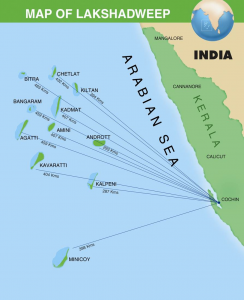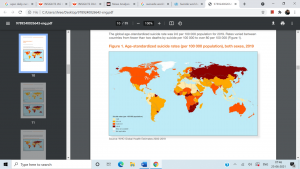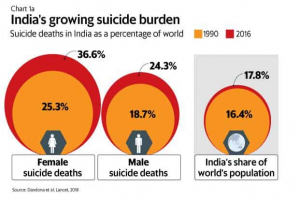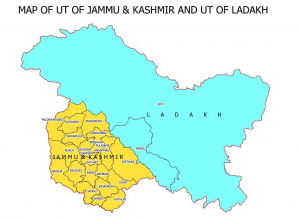Topics
- Jurisdiction of a High Court
- Suicide | WHO
- Delimitation | Jammu & Kashmir
- NISHTHA: Teachers’ Training Programme
- Nipah Virus | Antibodies
- Integrated Power Development Scheme
- Jurisdiction of a High Court
#GS2 #Judiciary #Separation of powers
Context: The Lakshadweep administration has mooted a proposal to shift its legal jurisdiction from the Kerala High Court to the Karnataka High Court.
Issue:
- The proposal was initiated by the administration after several litigations were moved before the Kerala High Court against the decisions taken by the Lakshadweep’s new Administrator Praful Khoda Patel.
- These decisions included revising standard operating procedures for COVID- appropriate behaviour, introduction of the “goonda Act” and demolishing huts of fishermen for widening of roads.
- This year, as many as 23 applications, including 11 writ petitions, have been filed against the administrator of Lakshadweep and also against the alleged high-handedness of either the police or the local government of the islands.
High Courts for Union Territories:
- Article 241 talks about “High Courts for Union territories”.
- As per the Constitution of India, “When a common High Court is established for more than one State, administrative expenses have to be paid only from the consolidated fund of the ‘State’ in which the principal seat of the High Court is situated”.
- The High Court is the supreme judicial body in a state and according to Article 214, each state of India shall have a High Court.
- However, Article 231 also mentions that there can be a common High Court for two or more States or for two or more states and a union territory.
- There are 25 High Courts in India, six having control over more than one State/UT. Delhi has a High Court of its own among the Union Territories.
What is the procedure to shift jurisdiction of a High Court?
- The jurisdiction of a High Court can be shifted only through an Act of Parliament.
- Parliament may by law constitute a high court for a Union Territory or declare any court in any such territory to be a high court for all or any of the purposes of this Constitution,” states Article 241 of the Constitution.
- Section 4 of the same article mentions that “nothing in this Article derogates from the power of Parliament to extend or exclude the jurisdiction of a high court for a State to, or from, any Union Territory or part thereof”.
Challenges ahead:
- Lakshadweep is under Kerala High Court jurisdiction now.
- Also, Malayalam is the spoken as well as the written language both in Kerala and Lakshadweep.
- Shifting of the jurisdiction of the high court will change the entire judicial system of the islands as all the judicial officers are sent from the Kerala High Court because of the common language and script
- It will break the bond of language.
- Also, the High Court in Kerala is just 400 kms away whereas that of Karnataka is over 1,000 kms with no direct connectivity as well.
- It would also mean extra-burden on the exchequer as all the cases, at present under trial, would have to be heard again afresh.

- Suicide | WHO
#GS1 #Population and associated issues #Sociology #International organisations
Context: Recently, a report titled Suicide worldwide in 2019 was published by the World Health Organization (WHO).
Highlights of the report:
- Unmet Target: Reducing the global suicide mortality rate by a third is both, an indicator and a target (the only one for mental health) in the United Nations-mandated Sustainable Development Goals (SDGs). But the world will not be able to reach this target.
- The SDGs call on countries to reduce premature mortality from non-communicable diseases by a third, by 2030 through prevention and treatment and to promote mental health and well-being (target 3.4, indicator 3.4.2).
- They ask countries to strengthen the prevention and treatment of substance abuse, including narcotic drug abuse and harmful use of alcohol. They also call for universal health coverage, which mental health is part of.
- Although some countries have placed suicide prevention high on their agendas, too many countries remain uncommitted, the report said.
- Currently, only 38 countries are known to have a national suicide prevention strategy.
- The Covid-19-pandemic has increased mental stress globally. However, a crisis was already in place in 2019 as more than 7 lakh people or one in a 100 in the world, died by suicide in 2019.
- Many of those who died in suicide were young people as more than half of global suicides (58%) occurred before the age of 50 years.
- Suicide was the fourth-leading cause of death among young people aged 15-29 globally in 2019.
- More than 75% of global suicides in 2019 occurred in low- and middle-income countries.
- Three WHO regions – Africa, Europe and South-East Asia recorded suicide rates higher than the global average.
- This number was highest in the WHO Africa region (11.2) followed by Europe (10.5) and South-East Asia (10.2).
- In 20 years (2000-2019), the global suicide rate had decreased by 36%.
- However, despite this overall decline, the world will not be able to achieve the SDGs concerning mental health, the report said.

Suicides in India:
- India has the highest suicide rate in the Southeast Asian region.
- A total of 1,34,516 cases of suicide were reported in 2018 in India, according to the National Crime Records Bureau.
- While the rate of suicide was 9.9 in 2017, it increased to 10.2 in 2018.

WHO Guidelines to Reduce Suicides:
- The WHO had published new LIVE LIFE guidelines to help countries reduce the global suicide mortality rate by a third by 2030. These are:
- Limiting access to the means of suicide, such as highly hazardous pesticides and firearms.
- Educating the media on responsible reporting of suicide.
- Fostering socio-emotional life skills in adolescents.
- Early identification, assessment, management and follow-up of anyone affected by suicidal thoughts and behaviour.
- These needed to go hand-in-hand with foundational pillars like situation analysis, multi-sectoral collaboration, awareness raising capacity building, financing, surveillance and monitoring and evaluation.
Related Indian Initiatives:
- Mental Healthcare Act, 2017
- KIRAN: The Ministry of Social Justice and Empowerment has launched a 24/7 toll-free helpline to provide support to people facing anxiety, stress, depression, suicidal thoughts and other mental health concerns.
- Manodarpan Initiative: It is an initiative of the Ministry of Education under Atmanirbhar Bharat Abhiyan. It is aimed to provide psychosocial support to students, family members and teachers for their mental health and well-being during the times of Covid-19.
- Delimitation | Jammu & Kashmir
#GS2 # Election Commission #Constitutionalbodies #Federal system
Context: Recently, the delimitation exercise has started in Jammu and Kashmir (J&K).
- The completion of the delimitation exercise will mark the political process in the Union Territory (UT) that has been under Centre’s rule since June 2018.
What is delimitation and why is it needed?
- Delimitation is the act of redrawing boundaries of an Assembly or Lok Sabha seat to represent changes in population over time.
- This exercise is carried out by a Delimitation Commission, whose orders have the force of law and cannot be questioned before any court.
- The key aim is to have equal representation to equal segments of the population in order to ensure a fair division of geographical areas so that all political parties or candidates contesting elections have a level playing field in terms of a number of voters.
- Aside from changing the limits of a constituency, the process may result in change in the number of seats in a state.
- Aside from changing the limits of a constituency, the process may result in change in the number of seats in a state.
- This exercise also involves reservation of Assembly seats for Scheduled Castes (SCs) and Scheduled Tribes (STs) in accordance with the Constitution.
How Delimitation is done?
- After every census, the Parliament will enact a Delimitation Act, as per Article 82.
- As per Article 170, the states also get classified into territorial constituencies after every census, according to the said Act.
- Once the Act is enacted, the Central Government sets up a Delimitation Commission.
- The Commission then exercises the delimitation.
- The Commission releases draft proposals to the public through the Gazette of India and the official gazettes of states, and also in regional language newspapers.
- It also conducts public sittings wherein the public’s opinion is heard through written or oral representations.
- If found appropriate, changes are made to the draft proposal.
- The final order is published in the Gazettes and comes into effect by a date specified by the President.
- However, the first delimitation exercise was carried out by the President (with the help of the Election Commission) in 1950-51.
- The Delimitation Commission Act was enacted in 1952.
- Delimitation Commissions have been set up four times — 1952, 1963, 1973 and 2002 under the Acts of 1952, 1962, 1972 and 2002.
- There was no delimitation after the 1981 and 1991 Censuses.
Delimitation in Jammu and Kashmir:
- The delimitation exercise in J&K in the past has been slightly different from those in the rest of the country because of the region’s special status.
- The delimitation of Lok Sabha seats was then governed by the Indian Constitution in J&K, but the delimitation of Assembly seats was governed separately by the Jammu and Kashmir Constitution and Jammu and Kashmir Representation of the People Act, 1957.
- However, Jammu and Kashmir lost its special status and was divided into two Union Territories (J&K and Ladakh) after the abrogation of its special status under Article 370, on 5th August, 2019.
- Following this, a special delimitation commission was constituted on 6th March, 2020 to carve out Assembly and Parliament seats in the UT.
- Assembly seats in J&K were delimited in 1963, 1973 and 1995. The last exercise was conducted by the Justice (retired) K K Gupta Commission when the state was under President’s Rule and was based on the 1981 census, which formed the basis of the state elections in 1996.
- There was no census in the state in 1991 and no Delimitation Commission was set up by the state government after the 2001 census as the J&K Assembly passed a law putting a freeze on the fresh delimitation of seats until 2026.
- This freeze was upheld by the Supreme Court.
- The J&K Assembly, at that time, had 87 seats — 46 in Kashmir, 37 in Jammu and 4 in Ladakh.
- Twenty-four more seats are reserved for Pakistan-occupied Kashmir. The freeze, some political parties argue, has created inequity for Jammu region.
Issues with Delimitation:
- States that take little interest in population control could end up with a greater number of seats in Parliament. The southern states that promoted family planning faced the possibility of having their seats reduced.
- In 2002-08, Delimitation was done based on the 2001 census, but the total number of seats in the Assemblies and Parliament decided as per the 1971 Census was not changed.
- The Constitution has also capped the number of Lok Shaba & Rajya Sabha seats to a maximum of 550 & 250 respectively and increasing populations are being represented by a single representative.
Delimitation Commission:
- The Delimitation Commission is appointed by the President of India and works in collaboration with the Election Commission of India.
- Composition:
- Retired Supreme Court judge
- Chief Election Commissioner
- Respective State Election Commissioners.
- If the members of the Commission have differing opinions, then the decision of the majority will be taken into consideration.
- On March 6, 2020, the government set up the Delimitation Commission, headed by retired Supreme Court judge Ranjana Prakash Desai.
- Although the Commission was tasked to finish delimitation in a year, on March 4 this year, it was granted a year’s extension.
- This was done at the request of the panel members since it couldn’t make much progress due to the Covid-19-induced shutdown across the country.

- NISHTHA: Teachers’ Training Programme:
#GS1 #Education #Tribal Affairs #GS2 # #Government Policies
Context: Ministry of Tribal Affairs and NCERT come together on a joint mission for NISHTHA Capacity Building Programme for Eklavya Model Residential Schools (EMRSs) Teachers and Principals.
About NISHTHA:
- National Initiative for School Heads and Teachers Holistic Advancement (NISHTHA) is a national mission to improve learning outcomes at the elementary level. This is done through integrated teacher training.
- It is the largest teachers’ training programme of its kind in the world.
- It has been launched under the Centrally Sponsored Scheme of Samagra Shiksha in 2109-20.
Main Aim:
- To motivate and equip teachers to encourage and foster critical thinking in students and also teachers will get awareness and develop their skills on various aspects.
Implementation:
- Training will be conducted directly by 33120 Key Resource Persons (KRPs) and State Resource Persons (SRP) identified by the State and UTs, who will in turn be trained by 120 National Resource Persons identified from National Council of Educational Research and Training (NCERT), National Institute of Educational Planning and Administration (NIEPA).
- A Mobile App and Learning Management System (LMS) based on MOODLE (Modular Object-Oriented Dynamic Learning Environment) have been developed by NCERT.
- LMS will be used for registration of Resource Persons and Teachers, dissemination of resources, training gap and impact analysis, monitoring, mentoring and measuring the progress online.
- Teachers will get awareness and develop their skills on various aspects related to:
- Learning Outcomes,
- Competency-Based learning and Testing,
- Learner-centered Pedagogy,
- School Safety and Security,
- Personal-social qualities,
- Inclusive Education,
- ICT in teaching-learning including Artificial Intelligence,
- Health and well-being including yoga,
- Initiatives in School Education including library, eco-club, youth club, kitchen garden,
- School Leadership qualities,
- Environmental Concerns,
- Pre-school, Pre-vocational Education and School-Based assessment.
Expected outcomes:
- Improvement in learning outcomes of the students.
- Creation of an enabling and enriching inclusive classroom environment.
- Teachers are trained as first level counselors to be alert and responsive to the social, emotional and psychological need of students.
- Teachers are trained to use Art as pedagogy leading to increased creativity and innovation among students.
- Teachers are trained to develop and strengthen personal-social qualities of students for their holistic development
- Develop stress-free School Based Assessment focused on development of learning competencies.
- Teachers adopt Activity Based Learning and move away from rote learning to competency-based learning.
- Nipah Virus | Antibodies
#GS3 #Science and technology #GS1 #Health
Context: A recent survey by the Indian Council of Medical Research (ICMR) – National Institute of Virology (NIV) has found the presence of antibodies against the Nipah virus (NiV) in some bat species from a cave in Mahabaleshwar, a popular hill station in Maharashtra.
About the Survey:
- The NIV team looked at Rousettus leschenaultii and Pipistrellus pipistrellus bats that are common in India.
- Pteropus medius bats, which are large fruit-eating bats, are the reservoir for NiV in India as both NiV RNA and antibodies were detected in the samples of these bats collected during previous NiV outbreaks.
- A bat’s immune system is especially adept at withstanding viral infection because of its ability to limit excessive inflammation — which uniquely allows viruses to thrive without proving deadly to the mammal.
- Researchers said it was difficult to infer any conclusion as only a few bats were screened during the present study.
Nipah virus (NiV):
- It is a zoonotic virus (it is transmitted from animals to humans).
- NiV is on the top-10 priority list pathogens identified by the World Health Organization.
- The organism which causes Nipah Virus encephalitis is an RNA or Ribonucleic acid virus of the family Paramyxoviridae, genus Henipavirus, and is closely related to Hendra virus.
- Hendra virus (HeV) infection is a rare emerging zoonosis that causes severe and often fatal disease in both infected horses and humans.
- It first broke out in Malaysia and Singapore in 1998 and 1999.
- It first appeared in domestic pigs and has been found among several species of domestic animals including dogs, cats, goats, horses and sheep.
- Till date, India has experienced four episodes of NiV outbreaks with CFR ranging from 65% to 100%.
- The first evidence of NiV infection was reported in Siliguri district, West Bengal in 2001, followed by Nadia district in West Bengal in 2007.
- A third outbreak occurred in Kozhikode district of Kerala state in 2018 with 18 case fatalities, followed by another outbreak in the same state in 2019.
- A study in 2018 has identified many South East Asian countries including Indian states as potential hotspots for the NiV disease.
Transmission:
- Nipah Virus is an airborne transmission infection and can affect those who come in direct contact with contaminated bodies such as pigs or bats carrying the virus.
- The disease spreads through fruit bats or ‘flying foxes,’ of the genus Pteropus, who are natural reservoir hosts of the Nipah and Hendra viruses.
- The virus is present in bat urine and potentially, bat faeces, saliva, and birthing fluids.
Symptoms:
- Nipah Virus is usually associated with inflammation of the brain due to which several days of fever can often lead to a state of confusion, disorientation and even persistent drowsiness.
- Encephalitis may also emerge as an acute or late-onset and can be a fatal complication of NiV.
- Neurological, respiratory and pulmonary signs also emerge in an infected individual.
- Some common signs and symptoms of NiV are drowsiness, dizziness, nausea, fever, headache and mental issues such as confusion.
Prevention:
- Currently, there are no vaccines for both humans and animals.
- The primary treatment for human cases is intensive supportive care and supportive medicines.
- Avoiding direct contact with contaminated bodies such as pigs or bats carrying the virus.
- Recurring outbreaks, high case fatality rate, human-to-human transmission and lack of effective vaccine/antivirals pose a major concern in India as bat roosts are very common in areas where large human populations reside.
- Additional efforts focused on surveillance and awareness will help prevent future outbreaks.
- Integrated Power Development Scheme:
#GS3 #Infrastructure #Industrial Policies
Context: A 50 kWp Solar roof top was inaugurated in Solan, Himachal Pradesh under the Integrated power development scheme (IPDS) of Ministry of Power.
About IPDS:
- It was launched in December, 2014 , by Ministry of Power.
- Power Finance Corporation Ltd. (PFC), a Navratna Central Public Sector Enterprise (CPSE) under the administrative control of the Ministry of Power acts as the nodal agency.
- All Discoms will be eligible for financial assistance under the scheme.
- Funding via Government of India Grant: 60% (85% for special category States).
- Additional Grant: 15% (5% for special category States) – linked to achievement of milestones.
Objectives and Components:
- 24×7 Power supplies for consumers.
- Reduction of AT&C (aggregate technical and commercial) losses.
- Providing access to power to all households.
- Strengthening of sub-transmission and distribution networks in the urban areas.
- Metering of distribution transformers in the urban areas.
- IT enablement of the distribution sector and strengthening of distribution network.
- Schemes for Enterprise Resource Planning (ERP) and IT enablement of balance urban towns.
- Underground cabling to include additional demand of States and smart metering solution for performing UDAY States and Solar panels on Govt. buildings with net-metering are also permissible under the scheme.
Other Government Initiatives related to power sector:
- Pradhan Mantri Sahaj Bijli Har Ghar Yojana (Saubhagya): To ensure electrification of all willing households in the country in rural as well as urban areas.
- Deendayal Upadhyaya Gram Jyoti Yojana (DDUGJY): The rural electrification scheme provides for (a) separation of agriculture and non-agriculture feeders; (b) strengthening and augmentation of sub-transmission and distribution infrastructure in rural areas including metering at distribution transformers, feeders and consumers end.
- GARV (Grameen Vidyutikaran) App: To monitor transparency in implementation of the electrification schemes, Grameen Vidyut Abhiyanta (GVAs) have been appointed by the government to report progress through the GARV app.
- Ujjwal Discom Assurance Yojana (UDAY): For operational and financial turnaround of Discoms.
Courses we offer
UPSC Civil Services Coaching ( We are the best top rated IAS Academy in Vijayawada and Andhra Pradesh by Times of India Excellence award)
Degree with IAS (BA and BSc plus UPSC Coaching)
Inter with IAS (Sarat Chandra Junior College provides intermediate plus UPSC Coaching with HEC, MEC, CEC along with CLAT, IIT HSEE, IPMAT)
